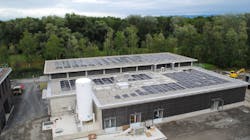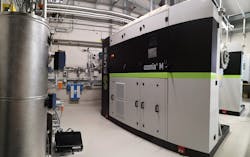Micropollutants are increasingly being detected at low levels in water systems around the world. Also known as contaminants of emerging concern (CECs), this ever-evolving class of pollutants refers to a wide range of different chemicals that include pharmaceuticals and personal care products (PPCPs), pesticides, endocrine disrupting chemicals (EDCs), per-and polyfluoroalkyl substances (PFAS), and many more. Evidence has linked multiple micropollutant categories, and a combined cocktail of multiple categories, to negative impacts on human health and the aquatic environment.
In 2014, Switzerland demonstrated world leadership in addressing micropollutants by revising the country’s Water Protection Ordinance to require additional treatment at certain large or critical wastewater treatment plants (WWTPs) for removing these substances. Switzerland’s actions were influenced in part by the United Nations (UN) Sustainable Development Goals (SDGs). Set in 2015, the 17 SDGs are the driving push behind the UN’s 2030 Agenda for Sustainable Development, adopted by all UN member states. Measures to combat micropollutants are included with Switzerland’s efforts to meet SDG 6: Ensure availability and sustainable management of water and sanitation for all.
To inform the amendments to its Water Protection Ordinance, Switzerland conducted studies that evaluated technologies for removing micropollutants from wastewater. Recognizing that conventional wastewater treatment was not adequate, the research focused on advanced technologies such as ozonation and activated carbon as post-conventional treatment options and identified these two technologies as the best available for treating micropollutants.
With the goal to meet the government’s 80 percent removal target and ensure sustainable water protection for several decades, Altenrhein embarked on a series of process improvements, implementing the best available technology in the industry. In September 2019, when the upgrades were finished and startup commenced, Altenrhein became the first WWTP in the world with a combined ozonation and granular activated carbon (GAC) system for micropollutant removal.
The advanced treatment stages were added to the end of Altenrhein’s existing treatment processes, which has a treatment capacity of 120,000 PE (Population Equivalent, or unit per capita loading), creating an upgraded flowsheet consisting of aeration, clarification, and sand filtration followed by ozone and GAC filtration. The advanced ozone technology is an Ozonia M ozone system from SUEZ – Water Technologies & Solutions, a high-performance ozone system that allows plants to reduce energy consumption by as much as 25 percent in a compact footprint. With the solution, plants can increase ozone capacity by as much as 20 percent, reducing the unit cost per kilogram of ozone produced. The system includes Ozonia IGS+ dielectric technology and the SmartO3 Technology Platform, which adds a variety of smart features optimized for ozone applications.
The Advantages of Ozone for Treating Micropollutants
To address the unique challenges of micropollutant removal, advanced treatment processes are needed for targeting constituents persisting at parts per billion concentration levels. Ozone is a pure disinfection solution for treating trace micropollutant concentrations, delivering robust oxidation and disinfection of many micropollutant categories including PPCPs, EDCs, pathogens, pesticides, biocides, cosmetics, trace organic compounds, and others.
At approximately 50 percent stronger than gaseous chlorine, ozone is one of the most powerful oxidants available for municipal and industrial treatment applications. It is also a stronger disinfectant compared to chlorine-based chemicals available today, allowing for lower dosage and shorter residence times in water. Neither chemicals nor chlorinated contaminants are added with the ozone treatment process and thus harmful residuals associated with added chlorinated chemical use is eliminated. Ozone additionally improves removal of organics and metals, and decays naturally into oxygen, creating a more oxygenated and purified product water. When discharged, the elevated dissolved oxygen (DO) concentration of the effluent can contribute to higher DO levels in receiving waters.
Ozone can be integrated at many points in a multi-treatment flowsheet and functions as a complementary technology to both filtration and carbon adsorption for targeting very low micropollutant concentrations. Since ozone is generated on site, safety problems associated with shipping and handling of chemicals are reduced.
Smart Control Strategies
During the technology evaluation process, Altenrhein looked closely at the total cost of the implemented solution, and specifically, cost-efficiency in terms of long-term operational expenses. This thinking led to an investigation into how the plant could improve the efficiency of the treatment process and reduce operational costs by optimizing control of ozone dosage in the framework of micropollutants removal. Delta UV control strategy emerged as a solution due to its representativity of the removal rate of micropollutants.
The strategy, which calculates the difference between UV measurements at the inlet and outlet, is especially useful where a removal rate is required, as plants can optimize their process control to adapt to that target. There is no online measurement available for the micropollutants directly, so the process cannot be optimized in real-time without a new measurement system. In the case of Altenrhein, the WWTP was able to apply Delta UV to reduce operating costs by optimizing the ozone dosage while achieving the 80 percent micropollutant removal requirement.
Along the same lines, Altenrhein is benefiting from another type of smart control technology that is included with the newest SUEZ Ozonia products. The SmartO3 automation platform adds a suite of advanced features that are designed to optimize system performance for increasing capacity, reducing energy consumption, and improving reliability. If remote connectivity is available and enabled, the advanced controller provides remote monitoring and diagnostics to improve operations and system availability.
Meeting Micropollutants Targets
Following commission of the ozonation and GAC upgrades, the Altenrhein WWTP has met Switzerland’s revised Water Protection Ordinance targets for micropollutant removal. The upgrades allow Altenrhein to address micropollutants using an effective and cost-efficient process. To further demonstrate the cleanliness of the effluent, a fish farm was established adjacent to Altenrhein’s visitor center, operated exclusively using purified effluent from the WWTP. The fish are evaluated regularly to confirm the high-quality water of their environment.
Looking ahead, as more countries prepare to address the issue of micropollutants in water resources, they can look to the work that was done in Switzerland as the basis for developing a technically and economically viable treatment strategy optimized to their specific challenges and needs. WW
About the Author: Trevor Dale is the global product manager at SUEZ – Water Technologies & Solutions for their ozone and UV equipment product lines. He joined SUEZ with the GE Water acquisition in 2017 and previously worked in business development and research and development roles since joining GE in 2008. He can be reached at [email protected].
About the Author
Trevor Dale
Trevor Dale is the global product manager at SUEZ – Water Technologies & Solutions for their ozone and UV equipment product lines. He joined SUEZ with the GE Water acquisition in 2017 and previously worked in business development and research and development roles since joining GE in 2008. He can be reached at [email protected].

